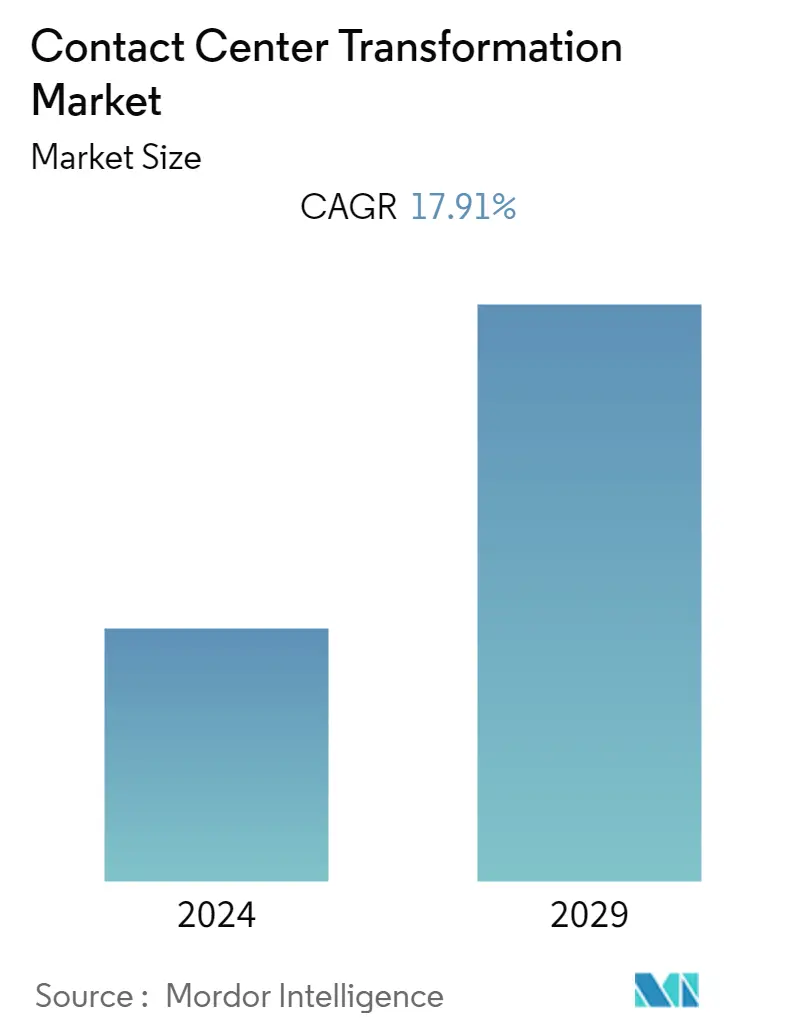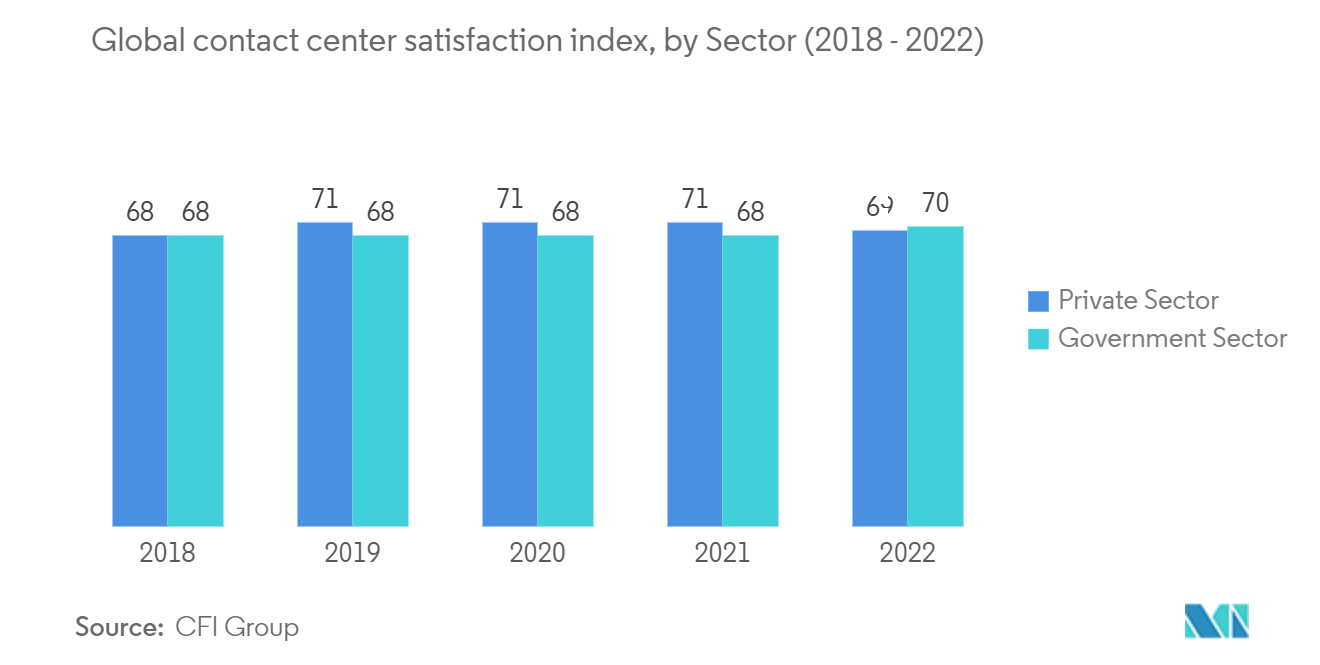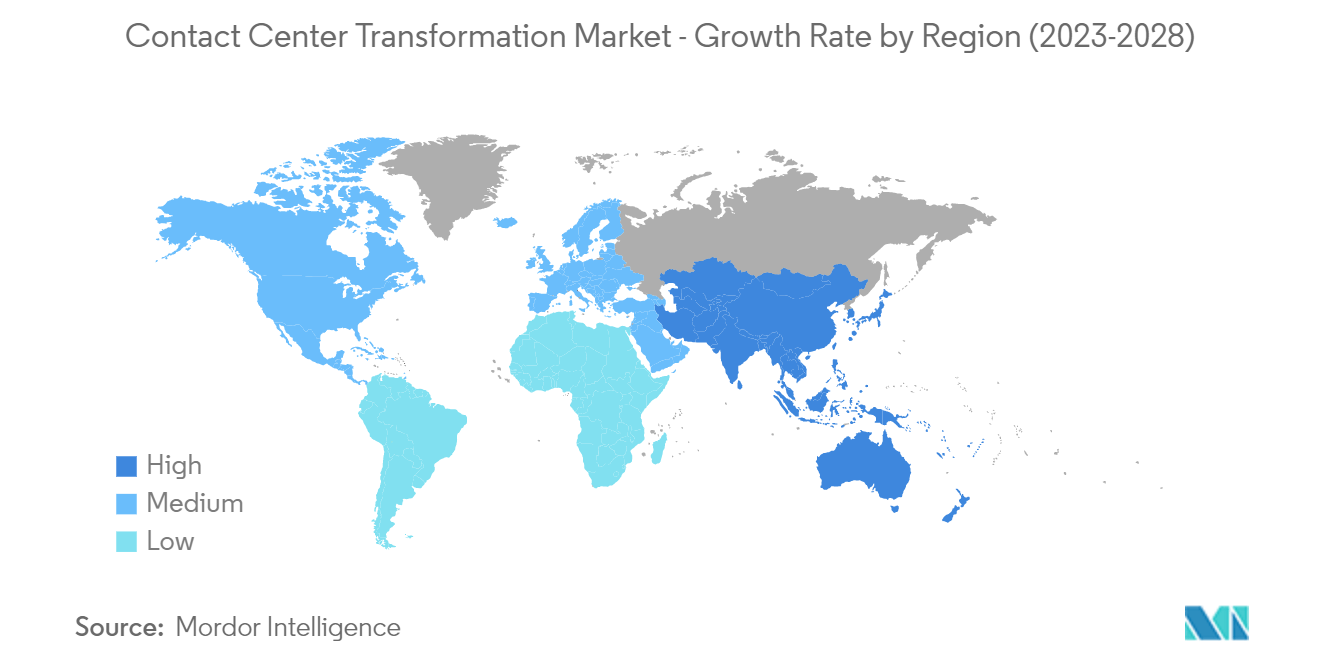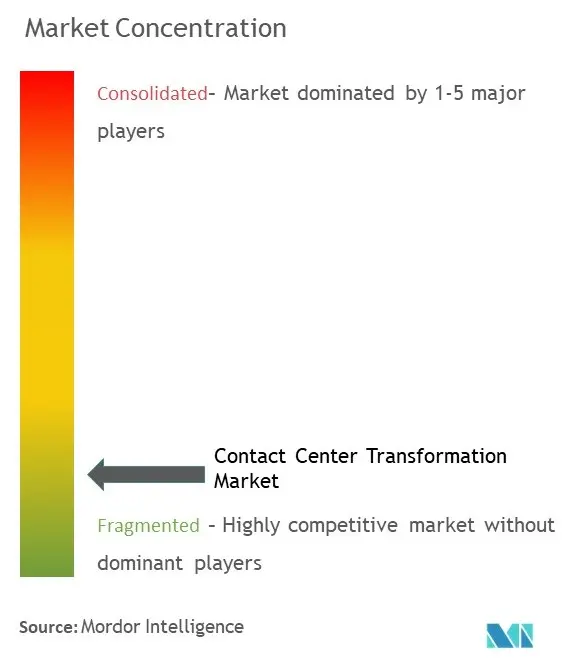Contact Center Transformation Market Size

| Study Period | 2019 - 2029 |
| Base Year For Estimation | 2023 |
| CAGR | 17.91 % |
| Fastest Growing Market | Asia Pacific |
| Largest Market | North America |
| Market Concentration | Low |
Major Players
*Disclaimer: Major Players sorted in no particular order |
Contact Center Transformation Market Analysis
The global contact center transformation market is expected to register a CAGR of 17.91% during the forecast period. As the cloud-based infrastructure has been digitally transforming the contact centers, flexibility and scalability are added. Benefits, such as the rapid expansion of resources to handle peaks during holiday seasons and scale back during other seasons, have been considered a crucial stage for most retailers. With no additional investments required toward infrastructure or management costs to manage the peak loads, such a digital outlook has been witnessed to transform contact centers increasingly.
- Businesses use automation modules to replace high-cost interaction channels, such as chatbots, with low-cost automated channels. Companies also utilize the interactive voice response (IVR) module, which enables operators to handle high call volumes. Furthermore, this module assists agents in providing good customer support by integrating databases, automatic speech recognition (ASR), and text-to-speech (TTS). This module also verifies callers so that they are routed to the appropriate contact center agent.
- The emerging trend of deploying Artificial Intelligence (AI) technology to enhance an agent's abilities to be more effective and efficient has been gaining traction. After being used to automate routine tasks, it ensures that human agents can better focus on escalated issues rather than mundane tasks.
- Businesses all over the world prefer cloud-based contact center solutions to on-premise solutions because of their ability to scale services. Cloud solutions are intended to connect agents to centralized contact center applications while also providing employees with a secure intranet to collaborate and communicate with one another.
- Moreover, cloud-based solutions can also provide detailed information about agents and customers that executives need help tracking with on-premise solutions. For instance, according to a RingCentral, Inc. study, switching to cloud-based solutions can help improve customer call answer rates by around 5% while decreasing the Average Speed of Answer (ASA) by up to 50%.
- Customer satisfaction is the primary goal of contact center performance because effective customer experience management drives immediate revenue and long-term success. Transformation automation solutions assist firms in improving the quality and efficacy of client inquiries while providing quick customer responses. Furthermore, an integrated automation solution connects the apps and systems in a single interface, allowing agents to create a unified knowledge base that offers real-time relevant data. This frees agents from handling manual, repetitive activities and lets them focus on improving their customer-centric abilities.
- For instance, a study conducted by Salesforce.com, Inc. states that approximately 84% of customers value a company's experience as much as its products and services. Businesses have also realized that better customer service can help boost profits. As a result, enterprises are aggressively adopting contact center solutions to improve customer service, thereby contributing to market growth.
- In automated customer service, chatbots respond to consumer issues such as buying, billing, product kinds, etc. However, certain situations go well beyond that, necessitating the use of a human agent to comprehend, negotiate, and discover a solution, and integration of new solutions with legacy systems is the challenge in the market.
- The COVID-19 outbreak is expected to have a positive and negative influence both on the market. The positive impact of COVID-19 is expected to fuel the growth of digitally enhanced contact centers. Call volumes at contact centers have grown as a result of the epidemic. Furthermore, some contact centers have maintained their vital interaction facilities, driving the demand for automation technologies. The market is expected to increase due to global digital transformation after the pandemic.
- Furthermore, the market saturation and infrastructure challenges to enable work-from-home created additional challenges worldwide that were hit hard by the COVID-19 pandemic lockdowns. Job creation in the global contact center industry has decreased by 36%.
- Moreover, most contact center industry employees quickly transitioned from facility-based to work-from-home. Despite the impact of the COVID-19 pandemic, the United States led overall job creation with 102 projects announced, totaling 36,196 jobs, a decrease of 48.2% from pre-COVID effects. The Latin America and Caribbean region was the second most active region, with 45 projects creating an estimated 29,250 jobs, a 21.4% decrease from the previous year.
Contact Center Transformation Market Trends
Intelligent Call Routing is Expected to Hold Significant Share
- Intelligent call routing simplifies the call process by connecting customers with the best agent for meeting their needs. In a typical contact/call center environment, the calls may be routed through interactive voice recording (IVR) to the most appropriate department or sent to an initial operator forwarding the call to the right person. However, intelligent call routing makes this process far more efficient.
- At a current measurement, 95-99% of the companies are randomly routing the customer calls or using methodology other than intelligent routing to connect calls to agents based on the customer's unique needs. In the current customer experience economy, the major focus is, thus, on personalized experience, which makes this option viable.
- Multiple organization leaders project an increased talent requirement for call centers, making automation an important element. Costly investments in training agents and hiring highly educated agents would be wasteful unless the customers connect to the right agent quickly. Intelligent call routing has proven useful in achieving this.
- Organizations struggling to use artificial intelligence (AI) to automate customer service are regarded the same as the lack of machines' capability to deal with natural languages. Though agents will not be fully automated anytime soon, intelligent call routing systems can help connect customers to agents most suited to solve their problems. A player such as Wise.io uses machine learning techniques to learn from the agents' prioritization of the customers. Its predictive engine creates tickets for the right agents to help them provide more personalized service quickly. Furthermore, knowing customers through their communication preferences and personality styles lets businesses personalize the customer experience at scale.
- Predictive Behavioral Routing (PBR) utilizes a proprietary and exclusively licensed language-based behavioral model with data for hundreds of millions of customers through millions of language-based personality algorithms. The same is known to transform the call router from a tactical call delivery tool into a strategic solution.

North America is Expected to Hold Significant Share
- North America is one of the prominent markets for contact center solutions and services, owing to the propensity and regulations governing enterprises to offer superior customer services in the region. The number of contact centers operating in the region is growing at a steady pace. According to the Bureau of Labor Statistics, the number of contact center employees in the United States in 2021 stood at 2.79 million.
- Businesses in North America have rapidly adopted and invested in emerging technologies such as cloud platforms, big data, and analytics. Furthermore, organizations must boost their regional company efficiency by improving export and incoming processes. Moreover, a significant number of contact centers in the area is likely to generate further potential for growth in the regional market.
- According to a survey conducted by the Site Selection Group, in the United States, there were 404 call centers opened or extended from 2016 to 2021. The increase in establishing new call centers and expanding call centers drives the contact center transformation market in the North American region.
- The companies present in the North American region are providing new solutions, for instance in September 2022, RingCentral Inc., one of the leading providers of global enterprise cloud communications, video meetings, collaboration, and contact center solutions, announced the release of AI-powered video capabilities and expanded browser compatibility for RingCentral MVPTM and RingCentral Video clients. With the current global workforce adopting hybrid work, there has never been a greater demand for quality and more intelligent meeting experiences.
- The enterprise propensity toward omnichannel contact centers in the region is increasing. Additionally, enterprises are increasingly looking to invest in technologies to enhance their revenues, as technology is directly linked to revenue growth.

Contact Center Transformation Industry Overview
The contact center transformation market is highly competitive due to constantly evolving technology. The new entrants have to scuffle with high capital requirements due to the technology-intensive nature of the market. The leverage of AI, ML, and Analytics makes it vital for them to keep track of competitive advancements constantly. Major companies like RingCentral Inc., NICE Systems Inc., 8x8 Inc., Genesys Telecommunications Laboratories Inc., and Five9 Inc., among others, are making strategic partnerships, mergers, and investments to retain their market position.
- January 2022 - RingCentral and Mitel announced a strategic partnership to enable a streamlined migration path to RingCentral's Message Video Phone (MVP) cloud communications platform for Mitel's global client base. As part of the partnership, RingCentral would become Mitel's sole UCaaS partner, providing the clients with a next-generation, mobile-first cloud communications platform with high reliability and security, functionality, and broad enterprise app integrations.
- August 2022 - Kyndryl and Five9 Announced a Partnership to Provide Customers with a Personalized, Cloud-Enabled Contact Center Experience. Kyndryl's Intelligent Cloud Contact Center (ICCC) platform would be delivered to new and existing customers using the combined strengths of Kyndryl's Digital Workplace Services and deep expertise in AI, automation, and cognitive analytics by Five9, one of the industry-leading cloud contact center technology.
Contact Center Transformation Market Leaders
-
RingCentral Inc.
-
NICE Systems Inc.
-
8x8 Inc.
-
Genesys Telecommunications Laboratories Inc.
-
Five9 Inc.
*Disclaimer: Major Players sorted in no particular order

Contact Center Transformation Market News
- June 2022 - 8x8, Inc., an integrated cloud communications platform, announced the 8x8 Elevate Microsoft Partner (MP) Program and the exclusive 8x8 XT edition, enabling enterprises to adopt Microsoft Teams to reduce communication costs and improve employee productivity through a highly resilient global telephony solution. 8x8 Voice for Microsoft Teams is a core component of 8x8 XCaaS (eXperience Communications as a Service), a single-vendor solution that offers fully integrated, cloud-native contact center, voice, team chat, video meetings, and CPaaS embeddable APIs capabilities.
- May 2022 - Sprinklr, the unified customer experience management (Unified-CXM) platform for modern organizations, announced a partnership with Twilio, the customer engagement platform that powers real-time, personalized interactions. Sprinklr clients could develop the next generation of contact centers by integrating Twilio voice and SMS technologies with Sprinklr Modern Care - a complete, cloud-based platform for real omnichannel customer care.
Contact Center Transformation Market Report - Table of Contents
1. INTRODUCTION
- 1.1 Study Assumptions and Market Definition
- 1.2 Scope of the Study
2. RESEARCH METHODOLOGY
3. EXECUTIVE SUMMARY
4. MARKET INSIGHTS
- 4.1 Market Overview
-
4.2 Industry Attractiveness - Porter's Five Forces Analysis
- 4.2.1 Bargaining Power of Suppliers
- 4.2.2 Bargaining Power of Consumers
- 4.2.3 Threat of New Entrants
- 4.2.4 Threat of Substitute Products
- 4.2.5 Intensity of Competitive Rivalry
5. MARKET DYNAMICS
-
5.1 Market Drivers
- 5.1.1 Need For Reduction in Overall Cost of Contact Center Management
- 5.1.2 Flexible Cloud-based Contact Center Solutions
-
5.2 Market Challenges
- 5.2.1 Integration of New Solutions with Legacy Systems
- 5.3 Impact of COVID-19 on Contact Center Software Market
6. ANALYSIS OF CONTACT CENTER TRANSFORMATION
- 6.1 Solution Roadmap Analysis
- 6.2 Impact of the convergence of AI, Machine Learning, and Automation in Contact Centers
-
6.3 Thematic Analysis on the Transformation of Contact Centers
- 6.3.1 Evolving Customer Preferences (Multi-channel Customer Engagement Trends, like Chatbots and Social Media)
- 6.3.2 Automation and Growth of Advanced Analytics in the Contact Center
- 6.3.3 Embracing Omnichannel-based Communication
- 6.4 Analysis of Major Advancements - Voice-based Biometrics and Real-time Analytics
7. MARKET SEGMENTATION
-
7.1 By Type
- 7.1.1 Intelligent Call Routing
- 7.1.2 Workforce Performance Optimization
- 7.1.3 Dialers
- 7.1.4 Interactive Voice Response
- 7.1.5 Computer Telephony Integration
- 7.1.6 Analytics and Reporting
- 7.1.7 Services (Consulting and Managed Services)
-
7.2 By Deployment
- 7.2.1 On-Premise
- 7.2.2 Hosted
-
7.3 By Organization Size
- 7.3.1 Small and Medium Enterprises
- 7.3.2 Large
-
7.4 By End-user Industry
- 7.4.1 Banking, Financial Services, and Insurance (BFSI)
- 7.4.2 IT and Telecom
- 7.4.3 Media and Entertainment
- 7.4.4 Retail and Consumer
- 7.4.5 Healthcare
- 7.4.6 Other End-user Industries
-
7.5 By Geography
- 7.5.1 North America
- 7.5.2 Europe
- 7.5.3 Asia-Pacific
- 7.5.4 Latin America
- 7.5.5 Middle East & Africa
8. COMPETITIVE LANDSCAPE
-
8.1 Company Profiles
- 8.1.1 RingCentral Inc.
- 8.1.2 NICE Systems Inc.
- 8.1.3 8x8 Inc.
- 8.1.4 Genesys Telecommunications Laboratories Inc.
- 8.1.5 Five9 Inc.
- 8.1.6 Avaya Inc.
- 8.1.7 Enghouse Interactive Inc.
- 8.1.8 Vocalcom SA
- 8.1.9 Mitel Networks Corp.
- 8.1.10 Altitude Software
- 8.1.11 Aspect Software Inc.
- *List Not Exhaustive
9. INVESTMENT ANALYSIS
10. FUTURE OF THE MARKET
** Subject To AvailablityContact Center Transformation Industry Segmentation
The study analyses the demand and adoption of contact center software and services solutions across key industry verticals. The study provides a detailed assessment of the transformation of contact centers over the last decade from single-channel (call) entities to omnichannel-based centers with advanced capabilities, mainly driven by the growing adoption of cloud-based solutions and technological advancements. The impact of COVID-19 on the overall contact center industry and its effect on the various deployment types are comprehensively analyzed in the study. Segmentation by deployment considers on-premise and hosted sub-segments, where hosted also realizes cloud based-deployments.
The contact center transformation market is segmented by type (intelligent call routing, workforce performance optimization, dialers, interactive voice response, computer telephony integration, analytics, and reporting, services (consulting and managed services), by deployment (on-premise, hosted), organization size ( small and medium enterprises, large enterprises), by end-user industry ( banking, financial services, and insurance (BFSI), IT and telecom, media and entertainment, retail and consumer, healthcare), and by geography (North America, Europe, Asia-pacific, Middle East & Africa, and Latin America). The market sizes and forecasts are provided in terms of value (USD million) for all the above segments.
| By Type | Intelligent Call Routing |
| Workforce Performance Optimization | |
| Dialers | |
| Interactive Voice Response | |
| Computer Telephony Integration | |
| Analytics and Reporting | |
| Services (Consulting and Managed Services) | |
| By Deployment | On-Premise |
| Hosted | |
| By Organization Size | Small and Medium Enterprises |
| Large | |
| By End-user Industry | Banking, Financial Services, and Insurance (BFSI) |
| IT and Telecom | |
| Media and Entertainment | |
| Retail and Consumer | |
| Healthcare | |
| Other End-user Industries | |
| By Geography | North America |
| Europe | |
| Asia-Pacific | |
| Latin America | |
| Middle East & Africa |
Contact Center Transformation Market Research FAQs
What is the current Contact Center Transformation Market size?
The Contact Center Transformation Market is projected to register a CAGR of 17.91% during the forecast period (2024-2029)
Who are the key players in Contact Center Transformation Market?
RingCentral Inc., NICE Systems Inc., 8x8 Inc., Genesys Telecommunications Laboratories Inc. and Five9 Inc. are the major companies operating in the Contact Center Transformation Market.
Which is the fastest growing region in Contact Center Transformation Market?
Asia Pacific is estimated to grow at the highest CAGR over the forecast period (2024-2029).
Which region has the biggest share in Contact Center Transformation Market?
In 2024, the North America accounts for the largest market share in Contact Center Transformation Market.
What years does this Contact Center Transformation Market cover?
The report covers the Contact Center Transformation Market historical market size for years: 2019, 2020, 2021, 2022 and 2023. The report also forecasts the Contact Center Transformation Market size for years: 2024, 2025, 2026, 2027, 2028 and 2029.
Contact Center Transformation Industry Report
Statistics for the 2024 Contact Center Transformation market share, size and revenue growth rate, created by Mordor Intelligence™ Industry Reports. Contact Center Transformation analysis includes a market forecast outlook 2029 and historical overview. Get a sample of this industry analysis as a free report PDF download.



